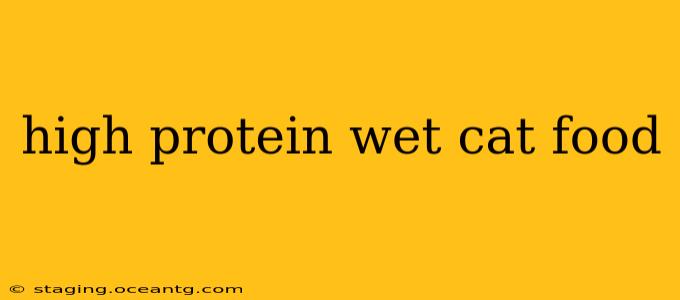Choosing the right food for your feline companion is crucial for their health and well-being. Cats, being obligate carnivores, require a diet rich in protein to thrive. While dry kibble offers convenience, many cat owners opt for wet food, particularly high-protein wet cat food, for its moisture content and palatability. This comprehensive guide explores the benefits, considerations, and selection process for high-protein wet cat food.
Why Choose High-Protein Wet Cat Food?
High-protein wet cat food offers several advantages over lower-protein options and even dry kibble:
-
Improved Kidney Function: Protein is essential for building and repairing tissues, but it's also crucial for maintaining healthy kidney function. Sufficient protein intake can help prevent kidney disease, a common ailment in older cats. However, it's important to note that the quality of protein matters more than just the quantity.
-
Enhanced Muscle Mass: Cats, like humans, need adequate protein to build and maintain muscle mass. High-protein diets can help prevent muscle loss, particularly in older or less active cats.
-
Increased Hydration: Wet food naturally contains a higher moisture content than dry kibble, helping cats stay hydrated. Dehydration can lead to various health problems, including urinary tract infections.
-
Better Palatability: Many cats find the taste and texture of wet food more appealing than dry kibble. This is particularly important for picky eaters or cats with dental issues.
What to Look For in High-Protein Wet Cat Food
Choosing the right high-protein wet food requires careful consideration of several factors:
-
Protein Source: Look for high-quality protein sources such as chicken, turkey, fish (like salmon or tuna), or lamb. Avoid brands that use vague terms like "meat by-products" or unspecified animal sources.
-
Protein Percentage: While a high protein percentage is desirable, it shouldn't be the only factor. Aim for a protein content of at least 7-8% but always consider the overall nutritional profile.
-
Fat Content: Cats need fat for energy and essential fatty acids. Look for a balance between protein and fat; excessively high fat content can be detrimental.
-
Ingredient List: The ingredient list should be clearly stated, with named ingredients listed in order of decreasing weight. Avoid foods with artificial colors, flavors, or preservatives.
-
Carbohydrate Content: Cats don't require many carbohydrates. Ideally, opt for foods with lower carbohydrate content, focusing instead on protein and fat.
-
Your Cat's Specific Needs: Consider your cat's age, activity level, and any pre-existing health conditions when selecting food. Consult your veterinarian for personalized dietary recommendations.
What are the Benefits of Feeding my Cat Wet Food Over Dry Food?
Wet food, especially high-protein versions, offers several advantages over dry kibble:
-
Higher Moisture Content: This helps cats stay hydrated, reducing the risk of urinary tract issues.
-
Increased Palatability: Many cats find the texture and taste of wet food more enjoyable.
-
Better Digestion: Some cats find wet food easier to digest than dry kibble.
Is High-Protein Cat Food Bad for Cats' Kidneys?
High-protein cat food is not inherently bad for cats' kidneys. In fact, sufficient high-quality protein is essential for maintaining healthy kidney function. However, cats with pre-existing kidney disease may require a special prescription diet with adjusted protein levels. Always consult your veterinarian before making significant dietary changes, especially for cats with health concerns.
How Much High-Protein Wet Food Should I Feed My Cat?
The amount of high-protein wet food you should feed your cat depends on factors like age, weight, activity level, and the specific food's nutritional content. Always follow the feeding guidelines on the food packaging, adjusting as needed to maintain a healthy weight for your cat. If unsure, consult your veterinarian.
Can I Mix High-Protein Wet Food and Dry Food?
Yes, you can mix high-protein wet food and dry food, but it's crucial to monitor your cat's weight and adjust the portions accordingly. Too much food, regardless of the type, can lead to obesity. Many cat owners use wet food as a topper for dry kibble to enhance palatability and increase water intake.
By carefully considering these factors and consulting your veterinarian, you can ensure your feline friend receives the best nutrition possible with high-protein wet cat food, promoting their overall health and happiness. Remember that providing fresh water alongside any diet is crucial for optimal hydration.
